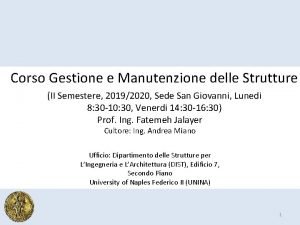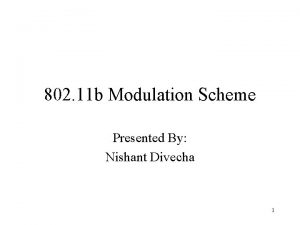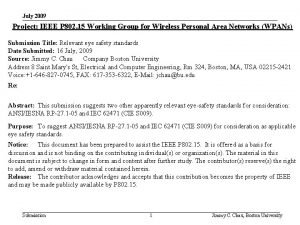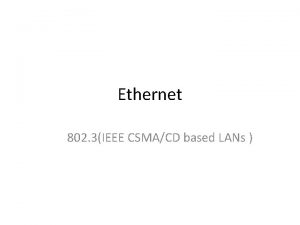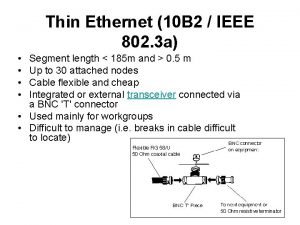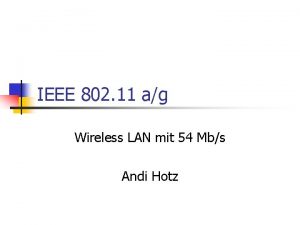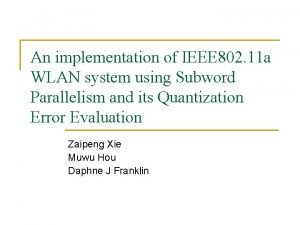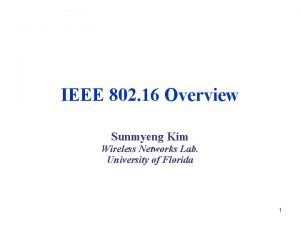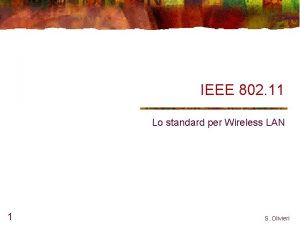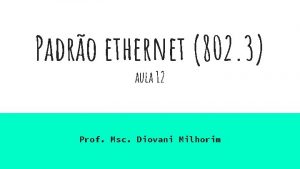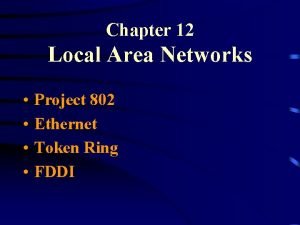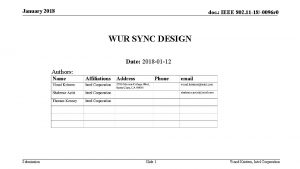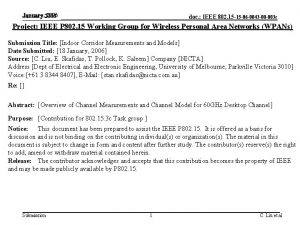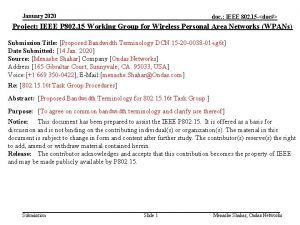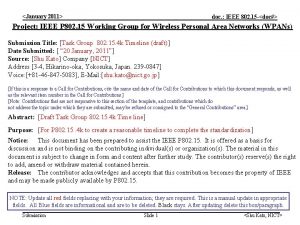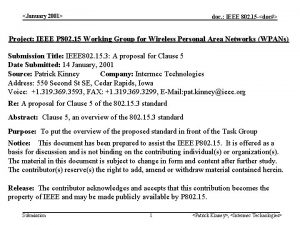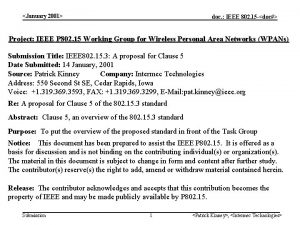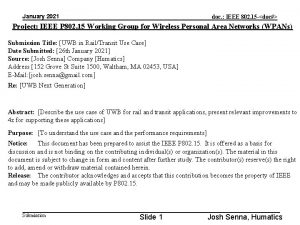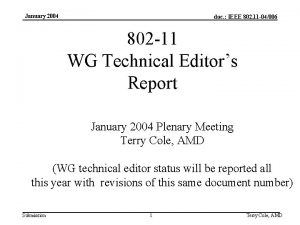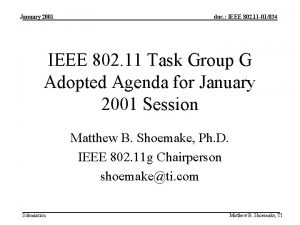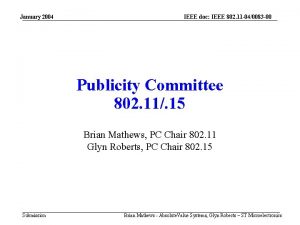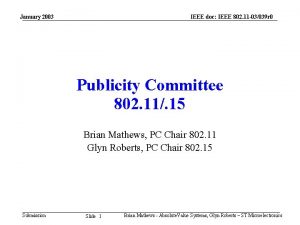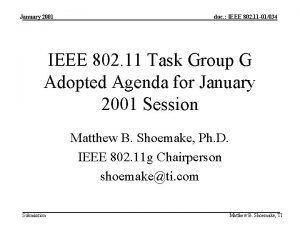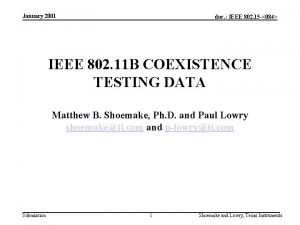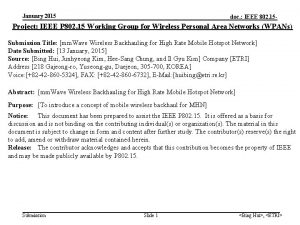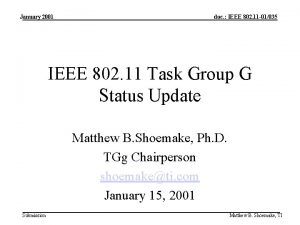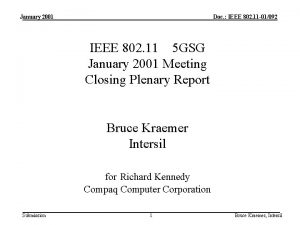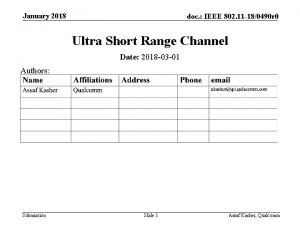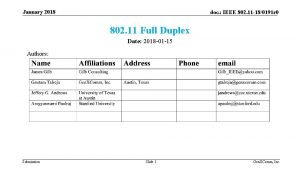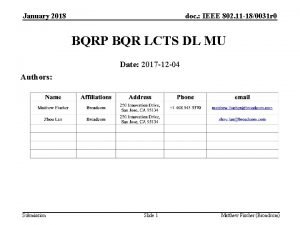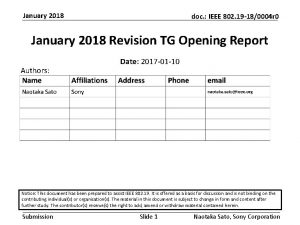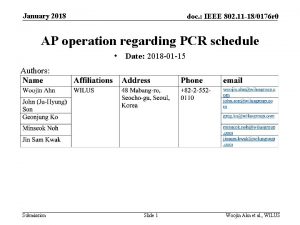January 2018 doc IEEE 802 11 180096 r























![January 2018 doc. : IEEE 802. 11 -18/-0096 r 2 References [1] 17/0997 r January 2018 doc. : IEEE 802. 11 -18/-0096 r 2 References [1] 17/0997 r](https://slidetodoc.com/presentation_image_h2/9599a92cf52ab4f5bea5f92e812bd28f/image-24.jpg)





- Slides: 29

January 2018 doc. : IEEE 802. 11 -18/-0096 r 2 WUR SYNC DESIGN Date: 2018 -01 -12 Authors: Submission Slide 1 Vinod Kristem, Intel Corporation

January 2018 doc. : IEEE 802. 11 -18/-0096 r 2 Preamble structure to support two rates • Based on the discussions [1]-[5], the motion has been passed for the following preamble structure to support two different rates • The exact bit sequence S and the bit duration is TBD 24 µs Legacy+WUR mark Wake-up preamble MAC header Low Rate Payload FCS S S 128 µs Higher Rate S Complement 64 µs Submission Slide 2 Vinod Kristem, Intel Corporation

January 2018 doc. : IEEE 802. 11 -18/-0096 r 2 Rate and timing detection the receiver • Received samples correlated with sequence S • Rate detection • Low rate transmission: 2 positive peaks, separated by PN seq length • High rate transmission: Single negative peak • Timing estimation • Correlation exceeds a threshold Submission Slide 3 Vinod Kristem, Intel Corporation

January 2018 doc. : IEEE 802. 11 -18/-0096 r 2 Candidate sequence S: PN sequence with different bit durations • Sequence S (64 us duration) • Zero padded 15 bit PN sequence, with 4 us bit duration • Zero padded 31 bit PN sequence, with 2 us bit duration • We evaluate and compare the performance of 4 us and 2 us preamble bit durations • Sequences with even smaller bit duration (1 us and below) can result in significant ISI and hence are not considered. Submission Slide 4 Vinod Kristem, Intel Corporation

January 2018 doc. : IEEE 802. 11 -18/-0096 r 2 Simulation parameters (Transmitter) 24 µs Legacy+WUR mark Wake-up preamble MAC header Payload FCS • Preamble: Low rate: [S S], High rate: [S complement] • Case 1: S - [0 15 bit PN seq. ], with 4 us bit duration • • 4 us OOK pulse constructed using 13 L-STF coefficients Case 2: S - [0 31 bit PN seq. ], with 2 us bit duration • 2 us OOK pulse generated using 32 pt. FFT in 20 MHz • Data portion: Manchester coding • Low rate scenario • Submission • ‘ 0’- 4 us ON, 4 us OFF, 4 us ON, 4 us OFF • ‘ 1’- 4 us OFF, 4 us ON, 4 us OFF, 4 us ON • 4 us OOK pulse constructed using 13 L-STF coefficients High rate scenario • ‘ 0’- 2 us ON, 2 us OFF • ‘ 1’- 2 us OFF, 2 us ON • 2 us OOK pulse generated using 32 pt. FFT in 20 MHz Slide 5 Vinod Kristem, Intel Corporation

January 2018 doc. : IEEE 802. 11 -18/-0096 r 2 Simulation parameters (Receiver) • • Submission 4 MHz LPF (IIR) – generated using MATLAB • Third order Butterworth filter • Cutoff freq. = 2. 5 MHz, Sampling freq. =160 MHz WUR processes (i) in-phase only (single rx chain); (ii) processes both I and Q Channels: AWGN and Channel D No phase noise and ACI modeled 2. 4 GHz band operation SNR is measured at 20 MHz bandwidth, post 4 MHz LPF Performance quantified with respect to ideal rate and timing Slide 6 Vinod Kristem, Intel Corporation

January 2018 doc. : IEEE 802. 11 -18/-0096 r 2 Performance of 4 us bit duration (WUR processes both I and Q) • Low rate scenario: No observable gap between ideal and estimated timing • High rate scenario: 0. 25 d. B loss in AWGN and 0. 5 d. B loss in Channel D Submission Slide 7 Vinod Kristem, Intel Corporation

January 2018 doc. : IEEE 802. 11 -18/-0096 r 2 Performance of 2 us bit duration (WUR processes both I and Q) • Performance gap < 0. 2 d. B, for both low and high rate scenarios Submission Slide 8 Vinod Kristem, Intel Corporation

January 2018 doc. : IEEE 802. 11 -18/-0096 r 2 Performance comparison (4 us Vs 2 us) • Performance measured with respect to ideal rate and ideal timing • Delta SNR corresponding to 10% PER levels AWGN , Low rate Channel D, Low rate AWGN, high rate Channel D, High rate < 0. 1 d. B 0. 15 d. B 0. 5 d. B < 0. 1 d. B 0. 2 d. B 0. 1 d. B < 0. 1 d. B • Good performance for both 2 us and 4 us bit durations • 2 us case is little better for High rate scenario in Channel D Submission Slide 9 Vinod Kristem, Intel Corporation

January 2018 doc. : IEEE 802. 11 -18/-0096 r 2 Other metrics for picking a preamble sequence • Desirable metrics for picking a preamble sequence • Good PER performance, measured in terms of SNR gap between the ideal timing and estimated timing • Ratio of strongest peak/next strongest peak in auto-correlation of sequence is one indicator • Smaller OFF (Silence) period in the preamble • Maximum consecutive 1’s or 0’s (run length) in the sequence S • Smaller OFF period is desirable • Other devices does not sense the channel as idle • Good for AGC implementation • At least 4 usec of OFF duration for preamble bit duration of 2 us • Sequence that enables efficient AGC implementation • Desirable to have small silence period at the beginning of the sequence Submission Slide 10 Vinod Kristem, Intel Corporation

January 2018 doc. : IEEE 802. 11 -18/-0096 r 2 Impact of silence period on AGC (1) Legacy Preamble + WUR-Mark (24μs) WUR Preamble (32 - bit, 2 us bit duration) Energy accumulation window for AGC gain setting 8 us OOK symbol gap 6 us OOK symbol gap • AGC gain typically set based on energy in the legacy preamble portion • • Energy accumulation window location can be arbitrary because of unknown packet start Large silence period results in inaccurate gain setting • Small OFF period in preamble is desirable • Enables smaller accumulation window and faster AGC gain convergence Submission Slide 11 Vinod Kristem, Intel Corporation

January 2018 doc. : IEEE 802. 11 -18/-0096 r 2 Impact of silence period on AGC (2) Legacy Preamble + WUR-Mark (24μs) WUR Preamble (32 - bit, 2 us bit duration) Energy accumulation window for AGC gain setting 8 us OOK symbol gap 6 us OOK symbol gap • Desirable to have smaller silence period at the beginning of the sequence • • • Consecutive zeros in the beginning can cause significant fluctuations in the AGC gains. Enables faster AGC gain convergence and locking Metric (Silence Period Location): How far into the preamble sequence, do we get a silence period of 4 us or more • For ex: [1 0 1 0 0 1……] with bit duration of 2 us, Metric = 10 us • Larger values are better for AGC Submission Slide 12 Vinod Kristem, Intel Corporation

January 2018 doc. : IEEE 802. 11 -18/-0096 r 2 Candidate sequences S with 2 us bit durations • Sequence S 1: Zero padded PN sequence • • • S 1 = [0 1 1 1 0 1 0 0 1 1 0 0 1 1 1 0 0 0 1 1 0] Maximum off time in S/S-Complement = 10 us Silence period location: 2 us into the sequence • Sequence S 2: Proposed sequence in [6] • • • S 2 = [0 1 1 1 0 1 0 1 1 0 0 0 1 1 0] Maximum off time in S/S-Complement = 6 us Silence period location: 2 us into the sequence • Sequence S 3: Proposed sequence in [7] • • • Submission S 3 = [1 0 0 1 0 1 1 1 0 0 1 1 1 0 0 0] Maximum off time in S/S-Complement = 6 us Silence period location: 6 us into the sequence Slide 13 Vinod Kristem, Intel Corporation

January 2018 doc. : IEEE 802. 11 -18/-0096 r 2 Candidate sequences S with 2 us bit durations • Sequence S 4: Our proposed sequence • • S 4 = [1 0 0 1 0 1 1 0 1 0 1] Maximum off time in S/S-Complement = 4 us Silence period location: 2 us into the sequence Generated by applying Manchester encoding [1 0]/[0 1] to zero padded 15 bit PN sequence • Sequence S 5: Our proposed sequence • • Submission S 5 = [1 0 1 0 0 1 1 0 0 1] Maximum off time in S/S-Complement = 4 us Silence period location: 14 us into the sequence Generated by applying cyclic shift to Sequence S 4 Slide 14 Vinod Kristem, Intel Corporation

January 2018 doc. : IEEE 802. 11 -18/-0096 r 2 Metrics of sequences S 1 -S 5 Sequence ACM (first maximum/second maximum) Max OFF time in S/S-complement Silence period location S 1 8 10 us 2 us S 2 5. 33 6 us 2 us S 3 8 6 us S 4 5. 33 4 us 2 us S 5 5. 33 4 us 14 us • S 4 and S 5 have the least OFF times • S 4 and S 5 have smaller ACM values than S 1 and S 3 • Does not necessarily translate to higher PER, as can be seen from simulation results • S 5 has the maximum silence period location • Consecutive 0’s/1’s in the sequence will start much later into the sequence Submission Slide 15 Vinod Kristem, Intel Corporation

January 2018 doc. : IEEE 802. 11 -18/-0096 r 2 PER with ideal rate and timing • Color codes: 5 different sequences – S 1 to S 5 • Very similar PER values for different sequences S • Expected as the timing is perfect Submission Slide 16 Vinod Kristem, Intel Corporation

January 2018 doc. : IEEE 802. 11 -18/-0096 r 2 PER with estimated rate and timing • Very similar performance for different sequences S, under different Tx rates and channel conditions • Performance gap between different sequences < 0. 2 d. B (@10% PER, 1% PER) • PER includes miss detection, rate miss classification, and false alarms Submission Slide 17 Vinod Kristem, Intel Corporation

January 2018 doc. : IEEE 802. 11 -18/-0096 r 2 Summary • Evaluated and compared the performance of preamble sequences with 2 us and 4 us bit durations • Very similar performance for low rate scenario • 2 us case slightly better in Channel D, for high rate scenario • Proposed 2 us bit duration sequences (S 4 and S 5), suitable for efficient AGC implementation • Smaller off period (especially at the beginning of preamble) is better for AGC • Evaluated the performance of different 32 -bit preamble sequences S, with bit duration of 2 us • Similar PER values for different channel models and Tx rates • The proposed sequences S 4 and S 5 have smallest OFF period (4 us) • Among the studied sequences, S 5 has the OFF period (>2 us), farthest into the preamble sequence Submission Slide 18 Vinod Kristem, Intel Corporation

January 2018 doc. : IEEE 802. 11 -18/-0096 r 2 Straw poll 1 Which of the options do you support for preamble bit duration • Option 1: 4 us bit duration • Yes • No • Abstain • Option 2: 2 us bit duration • Yes • No • Abstain Submission Slide 19 Vinod Kristem, Intel Corporation

January 2018 doc. : IEEE 802. 11 -18/-0096 r 2 Straw Poll 2 Do you support the following? The design of preamble sequence S or its complement (Low rate is indicated by [S S], High rate is indicated by [S complement]) should consider maximum OFF period. • Yes • No • Abstain Submission Slide 20 Vinod Kristem, Intel Corporation

January 2018 doc. : IEEE 802. 11 -18/-0096 r 2 Straw Poll 3 Do you support the following? The design of preamble sequence S or its complement (Low rate is indicated by [S S], High rate is indicated by [S complement]) should consider maximum OFF duration to enable fast AGC and to reduce the impact of channel sensing on third party 802. 11 stations. • Yes • No • Abstain Submission Slide 21 Vinod Kristem, Intel Corporation

January 2018 doc. : IEEE 802. 11 -18/-0096 r 2 Straw Poll 4 Do you support the following proposal? We propose to use the following 32 -bit preamble sequence S (S 5 in the presentation), with 2 us bit duration. S = [1 0 1 0 0 1 1 0 0 1]. (Low rate is indicated by [S S], High rate is indicated by [S complement]) • Yes • No • Abstain Submission Slide 22 Vinod Kristem, Intel Corporation

January 2018 doc. : IEEE 802. 11 -18/-0096 r 2 Straw Poll 5 Do you support the following? The preamble sequence S or its complement (Low rate is indicated by [S S], High rate is indicated by [S complement]) should be designed such that the contiguous OFF period is no more than 8 us. • Yes • No • Abstain Submission Slide 23 Vinod Kristem, Intel Corporation
![January 2018 doc IEEE 802 11 180096 r 2 References 1 170997 r January 2018 doc. : IEEE 802. 11 -18/-0096 r 2 References [1] 17/0997 r](https://slidetodoc.com/presentation_image_h2/9599a92cf52ab4f5bea5f92e812bd28f/image-24.jpg)
January 2018 doc. : IEEE 802. 11 -18/-0096 r 2 References [1] 17/0997 r 0 Preamble Options, IEEE 802. 11 TGba, July 2017 [2] 17/1781 r 1 Sync Structure Motions, IEEE 802. 11 TGba, Nov. 2017 [3] 17/1355 r 1 WUR Preamble Evaluation, IEEE 802. 11 TGba, September 2017 [4] 17/1345 r 5 11 ba PHY Frame Format Proposal, IEEE 802. 11 TGba, September 2017 [5] 17/1614 r 1 Preamble studies to indicate different data rates, IEEE 802. 11 TGba, Nov. 2017 [5] 18/0123 r 0 Options for Sync Field Bit Sequence, IEEE 802. 11 TGba, January 2018 [6] 18/0100 r 0 WUR Preamble Sequence Performance Evaluation, IEEE 802. 11 TGba, January 2018 Submission Slide 24 Vinod Kristem, Intel Corporation

January 2018 doc. : IEEE 802. 11 -18/-0096 r 2 Appendix Submission Slide 25 Vinod Kristem, Intel Corporation

January 2018 doc. : IEEE 802. 11 -18/-0096 r 2 Performance of 4 us bit duration (WUR processes only Inphase component) • Low rate scenario: No observable gap between ideal and estimated timing • High rate scenario: 0. 5 d. B loss in AWGN and 1 d. B loss in Channel D Submission Slide 23 Vinod Kristem, Intel Corporation

January 2018 doc. : IEEE 802. 11 -18/-0096 r 2 Performance of 2 us bit duration (WUR processes only Inphase component) • Performance gap < 0. 2 d. B, for high rate scenarios • Performance gap of 0. 4 d. B for low rate scenario Submission Slide 24 Vinod Kristem, Intel Corporation

January 2018 doc. : IEEE 802. 11 -18/-0096 r 2 Performance comparison (4 us Vs 2 us) (WUR processes only Inphase component) • Performance measured with respect to ideal rate and ideal timing • Delta SNR corresponding to 10% PER levels AWGN , Low rate Channel D, Low rate AWGN, high rate Channel D, High rate < 0. 1 d. B 0. 5 d. B 1 d. B 0. 4 d. B <0. 1 d. B 0. 2 d. B • 2 us case is better for High rate scenario Submission Slide 28 Vinod Kristem, Intel Corporation

January 2018 doc. : IEEE 802. 11 -18/-0096 r 2 PER with estimated rate and timing (WUR processing Only Inphase component) • Very similar performance for different sequences S • Performance gap between different sequences < 0. 2 d. B (@10% PER, 1% PER) Submission Slide 29 Vinod Kristem, Intel Corporation
 Bridges from 802.x to 802.y
Bridges from 802.x to 802.y Bridges from 802.x to 802.y
Bridges from 802.x to 802.y Arquitetura ieee 802
Arquitetura ieee 802 Estandares 802
Estandares 802 Ieee 802 standard
Ieee 802 standard Ieee 802 bluetooth
Ieee 802 bluetooth 802 ieee
802 ieee Ieee 802
Ieee 802 Ieee 802 family
Ieee 802 family Ieee 802 3 compliance
Ieee 802 3 compliance Ieee 802
Ieee 802 Chemistry january 2018 answers
Chemistry january 2018 answers 1st january 2018
1st january 2018 B a f c j e
B a f c j e Esempio piano di manutenzione delle strutture ntc 2018 doc
Esempio piano di manutenzione delle strutture ntc 2018 doc 802 protocols
802 protocols 802 11
802 11 Sybex ccna
Sybex ccna 09 802 0561
09 802 0561 Ethernet 802
Ethernet 802 802 family
802 family 802-3-ethernet
802-3-ethernet Lan 701
Lan 701 Wireless lan 802
Wireless lan 802 Wlan 802
Wlan 802 Modulation coding scheme
Modulation coding scheme 802/11
802/11 Ssin-802
Ssin-802 802 3
802 3 Project 802
Project 802














